Formation and Analysis of Volatile and Odor Compounds in Meat—A Review
Abstract
:1. Introduction
2. Odor Compounds in Meat
2.1. Formation of Odor Compounds
2.1.1. Maillard Reaction and Strecker Degradation
| Volatile Compound Class | Chemical Structure | Formation | General Odor Descriptors [17] 1 |
|---|---|---|---|
| Alcohol |  | Lipid oxidation [5] Carbohydrate fermentation 2 [17] | Saturated alcohols: high threshold. Straight-chain primary alcohols: flavorless. Increase in carbon chain: stronger flavor—greenish, woody, fatty floral. Unsaturated alcohols: mushroom, green leaf, musty. |
| Aldehyde |  | Lipid oxidation [5] | C3 and C4: sharp and irritating. C5–C9: green, oily, fatty, tallow. C10–C12: citrus orange peel. Alkyl-branched aldehydes: malty. |
| Carboxylic acid |  | Lipid oxidation [5] | Saturated acids: acidic. Unsaturated branched-chain acids: pungent, sour, penetrating. Keto acids: burnt, caramel, sour. |
| Ester | 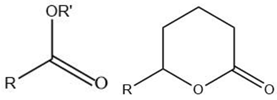 | Lipid oxidation [5] | Esters from C1–C10 acids: fruity sweet. Esters from long-chain fatty acids: fatty flavor. |
| Ketone |  | Lipid oxidation [5] | Unsaturated ketones: animal fat odors. 2-Alkanones: spicy, fruity, fatty, citrus-like. Lactones: oily, fruity, buttery, fatty. |
| Furan |  | Maillard reaction [16] Lipid oxidation [5] Carbohydrate degradation [14] | Alkylfurans: grassy, beany odor. |
| Furanone | 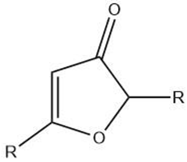 | Maillard reaction [5] | Fruity, fatty, roasty, roasted almonds, sweet aroma, pungent [11]. |
| Imidazole |  | Maillard reaction [16] | Amine-like [pubchem.org]. |
| Methylfuranthiol | 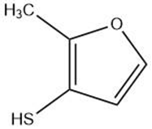 | Maillard reaction [5] Thiamine degradation [15] | Meaty aroma, roast meat, boiled meat [5,15]. |
| Oxazole | 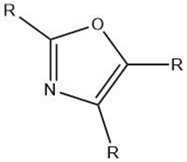 | Maillard reaction [16] Interaction 3 [14] | Green and vegetable-like [16]. |
| Pyrazine | 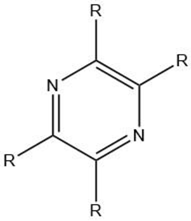 | Maillard reaction [12] Interaction 3 [14] | Pleasant aroma: nutty roast aroma, earthy, potato-like. |
| Pyridine |  | Maillard reaction [12] Interaction 3 [14] | Fatty tallow aroma. |
| Pyrrole | 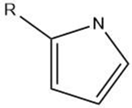 | Maillard reaction [12] | Burnt earthy odor. |
| Thiazole | 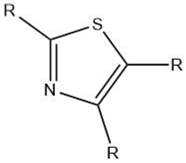 | Maillard reaction [14] Interaction 3 [14] | Green, vegetable-like, nutty, roasted. |
| Thiophene | 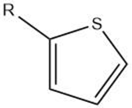 | Maillard reaction [16] Interaction 3 [14] Thiamine degradation [12] Nucleotide degradation [14] | Meaty aroma. |
| Alkanethiol |  | Maillard reaction [5] Thiamine degradation [14] | Meat-like, sulfurous, cabbage, onion, garlic-like. Associated with boiled meat. |
| Alkyl sulfide |  | Maillard reaction [14] Thiamine degradation [14] | |
| Alkyl disulfide |  | Maillard reaction [16] Thiamine degradation [14] |
2.1.2. Lipid Oxidation
2.1.3. Carbohydrate Degradation
2.1.4. Thiamine Degradation
2.2. Pre-Slaughter Factors Affecting Meat Volatile and Odor Development
2.2.1. Animal Species
2.2.2. Animal Breed
2.2.3. Sex of the Animal
2.2.4. Animal Age
2.2.5. Feed
2.2.6. Muscle Type
2.3. Post-Mortem Factors Affecting Meat Volatile and Odor Development
2.3.1. Chiller Aging
2.3.2. Curing
2.3.3. Fermentation
2.3.4. Irradiation
2.3.5. Cooking
2.4. Key Odor Compounds in the Meat of Various Species
3. Methods for the Determination of Volatile and Odor Compounds
3.1. Overview
3.2. Sample Preparation Techniques
3.2.1. Solid-Phase Microextraction (SPME)
3.2.2. Stir Bar Sorptive Extraction (SBSE)
3.2.3. Dynamic Headspace Extraction Techniques (DHS)
3.3. Gas Chromatography (GC)
3.4. Mass Spectrometry (MS)
3.5. Gas Chromatography-Olfactometry (GC-O)
3.6. Electronic Noses
3.7. Sensory Analysis of Meat
4. Conclusions and Perspectives
Author Contributions
Funding
Institutional Review Board Statement
Informed Consent Statement
Data Availability Statement
Conflicts of Interest
References
- Auvray, M.; Spence, C. The multisensory perception of flavor. Conscious. Cogn. 2008, 17, 1016–1031. [Google Scholar] [CrossRef] [PubMed]
- ISO_5492:2008; Sensory Analysis—Vocabulary. International Organization for Standardization: Geneva, Switzerland, 2008.
- Flores, M. Chapter 13—The Eating Quality of Meat: III—Flavor. In Lawrie’s Meat Science (Eighth Edition); Toldrá, F., Ed.; Woodhead Publishing: Sawston, UK, 2017; pp. 383–417. [Google Scholar]
- Shahidi, F. Flavor of meat and meat products—An overview. In Flavor of Meat and Meat Products; Shahidi, F., Ed.; Springer: Boston, MA, USA, 1994; pp. 1–3. [Google Scholar]
- Mottram, D.S. Flavour formation in meat and meat products: A review. Food Chem. 1998, 62, 415–424. [Google Scholar] [CrossRef]
- Reineccius, G. Flavor and aroma chemistry. In Quality Attributes and their Measurement in Meat, Poultry and Fish Products; Pearson, A.M., Dutson, T.R., Eds.; Springe: Boston, MA, USA, 1994; pp. 184–201. [Google Scholar]
- Pearson, A.M.; Gray, J.I.; Brennand, C.P. Species-specific flavors and odors. In Quality Attributes and their Measurement in Meat, Poultry and Fish Products; Pearson, A.M., Dutson, T.R., Eds.; Springer: Boston, MA, USA, 1994; pp. 222–249. [Google Scholar]
- Shahidi, F. Flavor of Cooked Meats. In Flavor Chemistry; ACS Symposium Series; American Chemical Society: Washington, DC, USA, 1989; Volume 388, pp. 188–201. [Google Scholar]
- Plotto, A.; Margaría, C.A.; Goodner, K.L.; Goodrich, R.; Baldwin, E.A. Odour and flavour thresholds for key aroma components in an orange juice matrix: Terpenes and aldehydes. Flavour Fragr. J. 2004, 19, 491–498. [Google Scholar] [CrossRef]
- Dunkel, A.; Steinhaus, M.; Kotthoff, M.; Nowak, B.; Krautwurst, D.; Schieberle, P.; Hofmann, T. Nature’s Chemical Signatures in Human Olfaction: A Foodborne Perspective for Future Biotechnology. Angew. Chem. Int. Ed. 2014, 53, 7124–7143. [Google Scholar] [CrossRef]
- Vilar, E.G.; O’Sullivan, M.G.; Kerry, J.P.; Kilcawley, K.N. Volatile organic compounds in beef and pork by gas chromatography-mass spectrometry: A review. Sep. Sci. Plus 2022, 5, 482–512. [Google Scholar] [CrossRef]
- Sun, A.; Wu, W.; Soladoye, O.P.; Aluko, R.E.; Bak, K.H.; Fu, Y.; Zhang, Y. Maillard reaction of food-derived peptides as a potential route to generate meat flavor compounds: A review. Food Res. Int. 2022, 151, 110823. [Google Scholar] [CrossRef]
- Belitz, H.-D.; Grosch, W.; Schieberle, P. Carbohydrates. In Food Chemistry, 3rd ed.; Springer: Berlin/Heidelberg, Germany, 2004; pp. 245–341. [Google Scholar]
- Diez-Simon, C.; Mumm, R.; Hall, R.D. Mass spectrometry-based metabolomics of volatiles as a new tool for understanding aroma and flavour chemistry in processed food products. Metabolomics 2019, 15, 41. [Google Scholar] [CrossRef] [Green Version]
- Resconi, V.; Escudero, A.; Campo, M.M. The Development of Aromas in Ruminant Meat. Molecules 2013, 18, 6748–6781. [Google Scholar] [CrossRef] [PubMed] [Green Version]
- Shahidi, F.; Samaranayaka, A.G.P.; Pegg, R.B. COOKING OF MEAT | Maillard Reaction and Browning. In Encyclopedia of Meat Sciences, 2nd ed.; Dikeman, M., Devine, C., Eds.; Academic Press: Oxford, UK, 2014; pp. 391–403. [Google Scholar]
- Flores, M. Understanding the implications of current health trends on the aroma of wet and dry cured meat products. Meat Sci. 2018, 144, 53–61. [Google Scholar] [CrossRef]
- Toldrá, F.; Flores, M. Processed Pork Meat Flavors. In Handbook of Food Products Manufacturing; Hui, Y.H., Ed.; John Wiley & Sons, Inc.: Hoboken, NJ, USA, 2007; Volume 2, pp. 281–301. [Google Scholar]
- Mottram, D.S.; Nobrega, I.C.C. Formation of Sulfur Aroma Compounds in Reaction Mixtures Containing Cysteine and Three Different Forms of Ribose. J. Agric. Food Chem. 2002, 50, 4080–4086. [Google Scholar] [CrossRef]
- Mottram, D.S.; Edwards, R.A. The role of triglycerides and phospholipids in the aroma of cooked beef. J. Sci. Food Agric. 1983, 34, 517–522. [Google Scholar] [CrossRef]
- Kerth, C.R.; Miller, R.K. Beef flavor: A review from chemistry to consumer. J. Sci. Food Agric. 2015, 95, 2783–2798. [Google Scholar] [CrossRef]
- Gray, J.I.; Gomaa, E.A.; Buckley, D.J. Oxidative quality and shelf life of meats. Meat Sci. 1996, 43, 111–123. [Google Scholar] [CrossRef]
- Ladikos, D.; Lougovois, V. Lipid oxidation in muscle foods: A review. Food Chem. 1990, 35, 295–314. [Google Scholar] [CrossRef]
- Kerler, J.; Grosch, W. Odorants Contributing to Warmed-Over Flavor (WOF) of Refrigerated Cooked Beef. J. Food Sci. 1996, 61, 1271–1275. [Google Scholar] [CrossRef]
- Angelo, A.J.S.; Vercellotti, J.R.; Legendre, M.G.; Vinnelt, C.H.; Kuan, J.W.; James, C., Jr.; Dupuy, H.P. Chemical and Instrumental Analyses of Warmed-Over Flavor in Beef. J. Food Sci. 1987, 52, 1163–1168. [Google Scholar] [CrossRef]
- Byrne, D.V.; Bak, L.S.; Bredie, W.L.P.; Bertelsen, C.; Martens, M. Development of a Sensory Vocabulary for Warmed-Over Flavor: Part I. In Porcine Meat. J. Sens. Stud. 1999, 14, 47–65. [Google Scholar] [CrossRef]
- Thomas, C.; Mercier, F.; Tournayre, P.; Martin, J.-L.; Berdagué, J.-L. Effect of added thiamine on the key odorant compounds and aroma of cooked ham. Food Chem. 2015, 173, 790–795. [Google Scholar] [CrossRef]
- Cannon, R.J.; Ho, C.-T. Volatile sulfur compounds in tropical fruits. J. Food Drug Anal. 2018, 26, 445–468. [Google Scholar] [CrossRef]
- Farmer, L.J.; Hagan, T.D.J. Precursors of flavour in cooked beef. In Proceedings of the 48th International Congress of Meat Science and Technology (ICoMST), Rome, Italy, 25–30 August 2002; pp. 322–323. Available online: www.icomst.helsinki.fi/Digicomst (accessed on 11 August 2022).
- Aliani, M.; Farmer, L.J. Precursors of Chicken Flavor. II. Identification of Key Flavor Precursors Using Sensory Methods. J. Agric. Food Chem. 2005, 53, 6455–6462. [Google Scholar] [CrossRef]
- Flores, M.; Perea-Sanz, L.; López-Díez, J.J.; Belloch, C. Meaty aroma notes from free amino acids and thiamine in nitrite-reduced, dry-fermented, yeast-inoculated sausages. Food Chem. 2021, 361, 129997. [Google Scholar] [CrossRef] [PubMed]
- Khan, M.I.; Jo, C.; Tariq, M.R. Meat flavor precursors and factors influencing flavor precursors—A systematic review. Meat Sci. 2015, 110, 278–284. [Google Scholar] [CrossRef] [PubMed]
- Wasserman, A.E.; Talley, F. Organoleptic Identification of Roasted Beef, Veal, Lamb and Pork as Affected by Fat. J. Food Sci. 1968, 33, 219–223. [Google Scholar] [CrossRef]
- Warriss, P.D. Measuring Eating Quality. In Meat Science: An Introductory Text; CABI Publishing: Wallingford, UK, 2000; pp. 252–268. [Google Scholar]
- Wilson, B.R.; Pearson, A.M.; Shorland, F.B. Effect of total lipids and phospholipids on warmed-over flavor in red and white muscle from several species as measured by thiobarbituric acid analysis. J. Agric. Food Chem. 1976, 24, 7–11. [Google Scholar] [CrossRef]
- De Smet, S.; Raes, K.; Demeyer, D. Meat fatty acid composition as affected by fatness and genetic factors: A review. Anim. Res. 2004, 53, 81–98. [Google Scholar] [CrossRef] [Green Version]
- Gorraiz, C.; Beriain, M.J.; Chasco, J.; Insausti, K. Effect of Aging Time on Volatile Compounds, Odor, and Flavor of Cooked Beef from Pirenaica and Friesian Bulls and Heifers. J. Food Sci. 2002, 67, 916–922. [Google Scholar] [CrossRef]
- Crouse, J.D.; Busboom, J.R.; Field, R.A.; Ferrell, C.L. The Effects of Breed, Diet, Sex, Location and Slaughter Weight on Lamb Growth, Carcass Composition and Meat Flavor. J. Anim. Sci. 1981, 53, 376–386. [Google Scholar] [CrossRef]
- Elmore, J.S.; Warren, H.E.; Mottram, D.S.; Scollan, N.D.; Enser, M.; Richardson, R.I.; Wood, J.D. A comparison of the aroma volatiles and fatty acid compositions of grilled beef muscle from Aberdeen Angus and Holstein-Friesian steers fed diets based on silage or concentrates. Meat Sci. 2004, 68, 27–33. [Google Scholar] [CrossRef]
- Ellis, M.; Webster, G.M.; Merrell, B.G.; Brown, I. The influence of terminal sire breed on carcass composition and eating quality of crossbred lambs. Anim. Sci. 1997, 64, 77–86. [Google Scholar] [CrossRef]
- Lorenzo, J.M.; Sarriés, M.V.; Franco, D. Sex effect on meat quality and carcass traits of foals slaughtered at 15 months of age. Animal 2013, 7, 1199–1207. [Google Scholar] [CrossRef] [PubMed]
- Bonneau, M. Use of entire males for pig meat in the European Union. Meat Sci. 1998, 49, S257–S272. [Google Scholar] [CrossRef]
- Bonneau, M.; Lebret, B. Production systems and influence on eating quality of pork. Meat Sci. 2010, 84, 293–300. [Google Scholar] [CrossRef] [PubMed]
- Matthews, K.R.; Homer, D.B.; Punter, P.; Béague, M.P.; Gispert, M.; Kempster, A.J.; Agerhem, H.; Claudi-Magnussen, C.; Fischer, K.; Siret, F.; et al. An international study on the importance of androstenone and skatole for boar taint: III. Consumer survey in seven European countries. Meat Sci. 2000, 54, 271–283. [Google Scholar] [CrossRef]
- Watkins, P.J.; Frank, D.; Singh, T.K.; Young, O.A.; Warner, R.D. Sheepmeat Flavor and the Effect of Different Feeding Systems: A Review. J. Agric. Food Chem. 2013, 61, 3561–3579. [Google Scholar] [CrossRef]
- Wood, J.D.; Enser, M. Factors influencing fatty acids in meat and the role of antioxidants in improving meat quality. Br. J. Nutr. 1997, 78, S49–S60. [Google Scholar] [CrossRef] [Green Version]
- Lorenz, S.; Buettner, A.; Ender, K.; Nürnberg, G.; Papstein, H.-J.; Schieberle, P.; Nürnberg, K. Influence of keeping system on the fatty acid composition in the longissimus muscle of bulls and odorants formed after pressure-cooking. Eur. Food Res. Technol. 2002, 214, 112–118. [Google Scholar] [CrossRef]
- Young, O.A.; Lane, G.A.; Priolo, A.; Fraser, K. Pastoral and species flavour in lambs raised on pasture, lucerne or maize. J. Sci. Food Agric. 2003, 83, 93–104. [Google Scholar] [CrossRef]
- Vasta, V.; Priolo, A. Ruminant fat volatiles as affected by diet. A review. Meat Sci. 2006, 73, 218–228. [Google Scholar] [CrossRef]
- Larick, D.K.; Hedrick, H.B.; Bailey, M.E.; Williams, J.E.; Hancock, D.L.; Garner, G.B.; Morrow, R.E. Flavor Constituents of Beef as Influenced by Forage- and Grain-Feeding. J. Food Sci. 1987, 52, 245–251. [Google Scholar] [CrossRef]
- Kosowska, M.; Majcher, M.A.; Fortuna, T. Volatile compounds in meat and meat products. Food Sci. Technol. 2017, 37, 1–7. [Google Scholar] [CrossRef]
- Koutsidis, G.; Elmore, J.S.; Oruna-Concha, M.J.; Campo, M.M.; Wood, J.D.; Mottram, D.S. Water-soluble precursors of beef flavour: I. Effect of diet and breed. Meat Sci. 2008, 79, 124–130. [Google Scholar] [CrossRef]
- Vasta, V.; Ratel, J.; Engel, E. Mass Spectrometry Analysis of Volatile Compounds in Raw Meat for the Authentication of the Feeding Background of Farm Animals. J. Agric. Food Chem. 2007, 55, 4630–4639. [Google Scholar] [CrossRef]
- Calkins, C.R.; Hodgen, J.M. A fresh look at meat flavor. Meat Sci. 2007, 77, 63. [Google Scholar] [CrossRef]
- Idolo Imafidon, G.; Spanier, A.M. Unraveling the secret of meat flavor. Trends Food Sci. Technol. 1994, 5, 315–321. [Google Scholar] [CrossRef]
- Brewer, M.S. Irradiation effects on meat flavor: A review. Meat Sci. 2009, 81, 1–14. [Google Scholar] [CrossRef] [PubMed]
- Madruga, M.S.; Mottram, D.S. The effect of pH on the formation of volatile compounds produced by heating a model system containing 5’-Imp and cysteine. J. Braz. Chem. Soc. 1998, 9, 261–271. [Google Scholar] [CrossRef] [Green Version]
- Spanier, A.M.; Flores, M.; McMillin, K.W.; Bidner, T.D. The effect of post-mortem aging on meat flavor quality in Brangus beef. Correlation of treatments, sensory, instrumental and chemical descriptors. Food Chem. 1997, 59, 531–538. [Google Scholar] [CrossRef]
- Koohmaraie, M.; Schollmeyer, J.E.; Dutson, T.R. Effect of Low-Calcium-Requiring Calcium Activated Factor on Myofibrils under Varying pH and Temperature Conditions. J. Food Sci. 1986, 51, 28–32. [Google Scholar] [CrossRef]
- Koutsidis, G.; Elmore, J.S.; Oruna-Concha, M.J.; Campo, M.M.; Wood, J.D.; Mottram, D.S. Water-soluble precursors of beef flavour. Part II: Effect of post-mortem conditioning. Meat Sci. 2008, 79, 270–277. [Google Scholar] [CrossRef]
- Moya, V.J.; Flores, M.; Aristoy, M.C.; Toldrá, F. Pork meat quality affects peptide and amino acid profiles during the ageing process. Meat Sci. 2001, 58, 197–206. [Google Scholar] [CrossRef]
- Beldarrain, L.R.; Morán, L.; Sentandreu, M.Á.; Barron, L.J.R.; Aldai, N. Effect of ageing time on the volatile compounds from cooked horse meat. Meat Sci. 2022, 184, 108692. [Google Scholar] [CrossRef] [PubMed]
- Flores, M.; Armero, E.; Aristoy, M.C.; Toldra, F. Sensory characteristics of cooked pork loin as affected by nucleotide content and post-mortem meat quality. Meat Sci. 1999, 51, 53–59. [Google Scholar] [CrossRef]
- Casaburi, A.; Piombino, P.; Nychas, G.-J.; Villani, F.; Ercolini, D. Bacterial populations and the volatilome associated to meat spoilage. Food Microbiol. 2015, 45, 83–102. [Google Scholar] [CrossRef] [PubMed]
- Toldrá, F. Chapter 9—The Storage and Preservation of Meat: III—Meat Processing. In Lawrie’s Meat Science, 8th ed.; Toldrá, F., Ed.; Woodhead Publishing: Sawston, UK, 2017; pp. 265–296. [Google Scholar]
- Feiner, G. Colour in fresh meat and in cured meat products. In Meat Products Handbook; Woodhead Publishing Limited: Cambridge, UK, 2006; pp. 142–157. [Google Scholar]
- Igene, J.O.; Yamauchi, K.; Pearson, A.M.; Gray, J.I.; Aust, S.D. Mechanisms by which nitrite inhibits the development of warmed-over flavour (WOF) in cured meat. Food Chem. 1985, 18, 1–18. [Google Scholar] [CrossRef]
- Bak, K.H.; Richards, M.P. Hexanal as a Predictor of Development of Oxidation Flavor in Cured and Uncured Deli Meat Products as Affected by Natural Antioxidants. Foods 2021, 10, 152. [Google Scholar] [CrossRef]
- Thomas, C.; Mercier, F.; Tournayre, P.; Martin, J.-L.; Berdagué, J.-L. Effect of nitrite on the odourant volatile fraction of cooked ham. Food Chem. 2013, 139, 432–438. [Google Scholar] [CrossRef]
- Feiner, G. Cured air-dried meat products. In Meat Products Handbook; Woodhead Publishing Limited: Cambridge, UK, 2006; pp. 417–441. [Google Scholar]
- Flores, M.; Olivares, A. Flavor. In Handbook of Fermented Meat and Poultry, 2nd ed.; Toldrá, F., Hui, Y.H., Astiasarán, I., Sebranek, J.G., Talon, R., Eds.; John Wiley & Sons, Ltd.: Chichester, UK, 2015; pp. 217–225. [Google Scholar]
- Söllner, K.; Schieberle, P. Decoding the Key Aroma Compounds of a Hungarian-Type Salami by Molecular Sensory Science Approaches. J. Agric. Food Chem. 2009, 57, 4319–4327. [Google Scholar] [CrossRef] [PubMed]
- Corral, S.; Leitner, E.; Siegmund, B.; Flores, M. Determination of sulfur and nitrogen compounds during the processing of dry fermented sausages and their relation to amino acid generation. Food Chem. 2016, 190, 657–664. [Google Scholar] [CrossRef] [Green Version]
- USDA. Irradiation and Food Safety FAQ. Available online: https://www.fsis.usda.gov/food-safety/safe-food-handling-and-preparation/food-safety-basics/irradiation-and-food-safety-faq#:~:text=In%201963%2C%20the%20Food%20and,an%20added%20layer%20of%20safety (accessed on 23 August 2022).
- European Commission. Directive 1999/2/EC of the European Parliament and of the Council of 22 February 1999 on the Approximation of the Laws of the Member States Concerning Foods and Food Ingredients Treated with Ionising Radiation (OJ L 066, 13.3.1999, p. 16); European Commission: Brussels, Belgium, 1999. [Google Scholar]
- European Commission. Foods & Food Ingredients Authorised for Irradiation in the EU. Available online: https://food.ec.europa.eu/safety/biological-safety/food-irradiation/legislation_en (accessed on 23 August 2022).
- Shahidi, F.; Hossain, A. Role of Lipids in Food Flavor Generation. Molecules 2022, 27, 5014. [Google Scholar] [CrossRef]
- Satyanarayan, V.T.; Honikel, K.-O. Effect of different cooking methods on warmed-over flavour development in pork. Z. Lebensm.-Unters. Forsch. 1992, 194, 422–425. [Google Scholar] [CrossRef]
- Meinert, L.; Andersen, L.T.; Bredie, W.L.P.; Bjergegaard, C.; Aaslyng, M.D. Chemical and sensory characterisation of pan-fried pork flavour: Interactions between raw meat quality, ageing and frying temperature. Meat Sci. 2007, 75, 229–242. [Google Scholar] [CrossRef]
- Ramírez, M.R.; Estévez, M.; Morcuende, D.; Cava, R. Effect of the Type of Frying Culinary Fat on Volatile Compounds Isolated in Fried Pork Loin Chops by Using SPME-GC-MS. J. Agric. Food Chem. 2004, 52, 7637–7643. [Google Scholar] [CrossRef]
- Feiner, G. Additives: Proteins, carbohydrates, fillers and other additives. In Meat Products Handbook; Woodhead Publishing Limited: Cambridge, UK, 2006; pp. 89–141. [Google Scholar]
- Sun, Y.; Zhang, Y.; Song, H. Variation of aroma components during frozen storage of cooked beef balls by SPME and SAFE coupled with GC-O-MS. J. Food Process. Preserv. 2021, 45, e15036. [Google Scholar] [CrossRef]
- Zang, M.; Wang, L.; Zhang, Z.; Zhang, K.; Li, D.; Li, X.; Wang, S.; Si, S.; Chen, H. Comparison of Volatile Flavor Compounds from Seven Types of Spiced Beef by Headspace Solid-phase Microextraction Combined with Gas Chromatography-olfactometry-mass Spectrometry (HS-SPME-GC-O-MS). Food Sci. Technol. Res. 2020, 26, 25–37. [Google Scholar] [CrossRef]
- Conte, F.; Cincotta, F.; Condurso, C.; Verzera, A.; Panebianco, A. Odor Emissions from Raw Meat of Freshly Slaughtered Cattle during Inspection. Foods 2021, 10, 2411. [Google Scholar] [CrossRef] [PubMed]
- Dharmadhikari, M. Sorbic Acid. Vineyard Vintage View 1992, 7, 1–5. [Google Scholar]
- Young, O.A.; Baumeister, B.M.B. The effect of diet on the flavour of cooked beef and the odour compounds in beef fat. N. Z. J. Agric. Res. 1999, 42, 297–304. [Google Scholar] [CrossRef]
- Song, X.; Zhu, L.; Wang, X.; Zheng, F.; Zhao, M.; Liu, Y.; Li, H.; Zhang, F.; Zhang, Y.; Chen, F. Characterization of key aroma-active sulfur-containing compounds in Chinese Laobaigan Baijiu by gas chromatography-olfactometry and comprehensive two-dimensional gas chromatography coupled with sulfur chemiluminescence detection. Food Chem. 2019, 297, 124959. [Google Scholar] [CrossRef] [PubMed]
- Wang, B.; Qu, F.; Wang, P.; Zhao, L.; Wang, Z.; Han, Y.; Zhang, X. Characterization analysis of flavor compounds in green teas at different drying temperature. LWT 2022, 161, 113394. [Google Scholar] [CrossRef]
- Macleod, G.; Ames, J.M. The effect of heat on beef aroma: Comparisons of chemical composition and sensory properties. Flavour Fragr. J. 1986, 1, 91–104. [Google Scholar] [CrossRef]
- Xiao, Z.; Niu, M.; Niu, Y.; Zhu, J. Evaluation of the Perceptual Interaction Among Sulfur Compounds in Durian by Feller’s Additive Model and Odor Activity Value. Food Anal. Methods 2022, 15, 1787–1802. [Google Scholar] [CrossRef]
- Pavlidis, D.E.; Mallouchos, A.; Ercolini, D.; Panagou, E.Z.; Nychas, G.-J.E. A volatilomics approach for off-line discrimination of minced beef and pork meat and their admixture using HS-SPME GC/MS in tandem with multivariate data analysis. Meat Sci. 2019, 151, 43–53. [Google Scholar] [CrossRef]
- Chen, G.; Su, Y.; He, L.; Wu, H.; Shui, S. Analysis of volatile compounds in pork from four different pig breeds using headspace solid-phase micro-extraction/gas chromatography–mass spectrometry. Food Sci. Nutr. 2019, 7, 1261–1273. [Google Scholar] [CrossRef] [PubMed]
- Han, D.; Zhang, C.-H.; Fauconnier, M.-L.; Mi, S. Characterization and differentiation of boiled pork from Tibetan, Sanmenxia and Duroc × (Landrac × Yorkshire) pigs by volatiles profiling and chemometrics analysis. Food Res. Int. 2020, 130, 108910. [Google Scholar] [CrossRef] [PubMed]
- Wood, W.F.; Brandes, M.L.; Watson, R.L.; Jones, R.L.; Largent, D.L. Trans-2-Nonenal, the cucumber odor of mushrooms. Mycologia 1994, 86, 561–563. [Google Scholar] [CrossRef]
- Ishino, K.; Wakita, C.; Shibata, T.; Toyokuni, S.; Machida, S.; Matsuda, S.; Matsuda, T.; Uchida, K. Lipid Peroxidation Generates Body Odor Component trans-2-Nonenal Covalently Bound to Protein In Vivo. J. Biol. Chem. 2010, 285, 15302–15313. [Google Scholar] [CrossRef] [Green Version]
- Chen, G.; Sui, Y.; Chen, S. Detection of flavor compounds in longissimus muscle from four hybrid pig breeds of Sus scrofa, Bamei pig, and Large White. Biosci. Biotechnol. Biochem. 2014, 78, 1910–1916. [Google Scholar] [CrossRef]
- Machiels, D.; van Ruth, S.M.; Posthumus, M.A.; Istasse, L. Gas chromatography-olfactometry analysis of the volatile compounds of two commercial Irish beef meats. Talanta 2003, 60, 755–764. [Google Scholar] [CrossRef]
- Rochat, S.; Chaintreau, A. Carbonyl Odorants Contributing to the In-Oven Roast Beef Top Note. J. Agric. Food Chem. 2005, 53, 9578–9585. [Google Scholar] [CrossRef]
- Carrapiso, A.I.; Martín, L.; Jurado, Á.; García, C. Characterisation of the most odour-active compounds of bone tainted dry-cured Iberian ham. Meat Sci. 2010, 85, 54–58. [Google Scholar] [CrossRef]
- Pu, D.; Zhang, Y.; Zhang, H.; Sun, B.; Ren, F.; Chen, H.; Tang, Y. Characterization of the Key Aroma Compounds in Traditional Hunan Smoke-Cured Pork Leg (Larou, THSL) by Aroma Extract Dilution Analysis (AEDA), Odor Activity Value (OAV), and Sensory Evaluation Experiments. Foods 2020, 9, 413. [Google Scholar] [CrossRef]
- Ba, H.V.; Oliveros, M.C.; Ryu, K.-S.; Hwang, I.-H. Development of Analysis Condition and Detection of Volatile Compounds from Cooked Hanwoo Beef by SPME-GC/MS Analysis. Korean J. Food Sci. Anim. Resour. 2010, 30, 73–86. [Google Scholar] [CrossRef] [Green Version]
- Scalone, G.L.L.; Ioannidis, A.G.; Lamichhane, P.; Devlieghere, F.; De Kimpe, N.; Cadwallader, K.; De Meulenaer, B. Impact of whey protein hydrolysates on the formation of 2,5-dimethylpyrazine in baked food products. Food Res. Int. 2020, 132, 109089. [Google Scholar] [CrossRef] [PubMed]
- Sohail, A.; Al-Dalali, S.; Wang, J.; Xie, J.; Shakoor, A.; Asimi, S.; Shah, H.; Patil, P. Aroma compounds identified in cooked meat: A review. Food Res. Int. 2022, 157, 111385. [Google Scholar] [CrossRef]
- Ayseli, M.T.; Filik, G.; Selli, S. Evaluation of volatile compounds in chicken breast meat using simultaneous distillation and extraction with odour activity value. J. Food Nutr. Res. 2014, 53, 137–142. [Google Scholar]
- Bi, J.; Lin, Z.; Li, Y.; Chen, F.; Liu, S.; Li, C. Effects of different cooking methods on volatile flavor compounds of chicken breast. J. Food Biochem. 2021, 45, e13770. [Google Scholar] [CrossRef]
- Yu, Y.; Wang, G.; Luo, Y.; Pu, Y.; Ge, C.; Liao, G. Effect of natural spices on precursor substances and volatile flavor compounds of boiled Wuding chicken during processing. Flavour Fragr. J. 2020, 35, 570–583. [Google Scholar] [CrossRef]
- Wang, F.; Gao, Y.; Wang, H.; Xi, B.; He, X.; Yang, X.; Li, W. Analysis of volatile compounds and flavor fingerprint in Jingyuan lamb of different ages using gas chromatography–ion mobility spectrometry (GC–IMS). Meat Sci. 2021, 175, 108449. [Google Scholar] [CrossRef]
- Luo, Y.; Wang, B.; Liu, C.; Su, R.; Hou, Y.; Yao, D.; Zhao, L.; Su, L.; Jin, Y. Meat quality, fatty acids, volatile compounds, and antioxidant properties of lambs fed pasture versus mixed diet. Food Sci. Nutr. 2019, 7, 2796–2805. [Google Scholar] [CrossRef] [Green Version]
- Kaffarnik, S.; Preuß, S.; Vetter, W. Direct determination of flavor relevant and further branched-chain fatty acids from sheep subcutaneous adipose tissue by gas chromatography with mass spectrometry. J. Chromatogr. A 2014, 1350, 92–101. [Google Scholar] [CrossRef]
- Ma, Y.; Tang, K.; Xu, Y.; Thomas-Danguin, T. A dataset on odor intensity and odor pleasantness of 222 binary mixtures of 72 key food odorants rated by a sensory panel of 30 trained assessors. Data Brief 2021, 36, 107143. [Google Scholar] [CrossRef] [PubMed]
- Yang, C.; Song, H.L.; Chen, F. Response Surface Methodology for Meat-like Odorants from Maillard Reaction with Glutathione I: The Optimization Analysis and the General Pathway Exploration. J. Food Sci. 2012, 77, C966–C974. [Google Scholar] [CrossRef] [PubMed]
- Liu, Y.; Song, H.; Luo, H. Correlation between the key aroma compounds and gDNA copies of Bacillus during fermentation and maturation of natto. Food Res. Int. 2018, 112, 175–183. [Google Scholar] [CrossRef] [PubMed]
- Zhan, P.; Tian, H.; Zhang, X.; Wang, L. Contribution to aroma characteristics of mutton process flavor from the enzymatic hydrolysate of sheep bone protein assessed by descriptive sensory analysis and gas chromatography olfactometry. J. Chromatogr. B 2013, 921–922, 1–8. [Google Scholar] [CrossRef]
- Belitz, H.-D.; Grosch, W.; Schieberle, P. Aroma Compounds. In Food Chemistry, 3rd ed.; Springer: Berlin/Heidelberg, Germany, 2004; pp. 342–408. [Google Scholar]
- Hübschmann, H.-J. Introduction. In Handbook of GC-MS. Fundamentals and Applications, 3rd ed.; Wiley-VCH: Weinheim, Germany, 2015; pp. 1–6. [Google Scholar]
- Hübschmann, H.-J. Fundamentals. In Handbook of GC-MS. Fundamentals and Applications, 3rd ed.; Wiley-VCH: Weinheim, Germany, 2015; pp. 7–354. [Google Scholar]
- Narváez-Rivas, M.; Gallardo, E.; León-Camacho, M. Analysis of volatile compounds from Iberian hams: A review. Grasas Aceites 2012, 63, 432–454. [Google Scholar] [CrossRef] [Green Version]
- Callejón, R.M.; Ubeda, C.; Ríos-Reina, R.; Morales, M.L.; Troncoso, A.M. Recent developments in the analysis of musty odour compounds in water and wine: A review. J. Chromatogr. A 2016, 1428, 72–85. [Google Scholar] [CrossRef]
- Bhadury, D.; Nolvachai, Y.; Marriott, P.J.; Tanner, J.; Tuck, K.L. Detection of Volatiles from Raw Beef Meat from Different Packaging Systems Using Solid-Phase Microextraction GC–Accurate Mass Spectrometry. Foods 2021, 10, 2018. [Google Scholar] [CrossRef]
- Caja, M.M.; Ruiz del Castillo, M.L.; Blanch, G.P. Solid phase microextraction as a methodology in the detection of irradiation markers in ground beef. Food Chem. 2008, 110, 531–537. [Google Scholar] [CrossRef]
- Kim, H.; Cho, W.-J.; Ahn, J.-S.; Cho, D.-H.; Cha, Y.-J. Identification of radiolytic marker compounds in the irradiated beef extract powder by volatile analysis. Microchem. J. 2005, 80, 127–137. [Google Scholar] [CrossRef]
- Elmore, J.S.; Mottram, D.S.; Hierro, E. Two-fibre solid-phase microextraction combined with gas chromatography–mass spectrometry for the analysis of volatile aroma compounds in cooked pork. J. Chromatogr. A 2001, 905, 233–240. [Google Scholar] [CrossRef]
- Song, X.; Canellas, E.; Nerin, C. Screening of volatile decay markers of minced pork by headspace-solid phase microextraction–gas chromatography–mass spectrometry and chemometrics. Food Chem. 2021, 342, 128341. [Google Scholar] [CrossRef] [PubMed]
- Hoa, V.-B.; Seol, K.-H.; Seo, H.-W.; Seong, P.-N.; Kang, S.-M.; Kim, Y.-S.; Moon, S.-S.; Kim, J.-H.; Cho, S.-H. Meat quality characteristics of pork bellies in relation to fat level. Anim. Biosci. 2021, 34, 1663–1673. [Google Scholar] [CrossRef]
- Han, D.; Zhang, C.-H.; Fauconnier, M.-L. Effect of Seasoning Addition on Volatile Composition and Sensory Properties of Stewed Pork. Foods 2021, 10, 83. [Google Scholar] [CrossRef] [PubMed]
- Han, D.; Zhang, C.-H.; Fauconnier, M.-L.; Jia, W.; Wang, J.-F.; Hu, F.-F.; Xie, D.-W. Characterization and comparison of flavor compounds in stewed pork with different processing methods. LWT 2021, 144, 111229. [Google Scholar] [CrossRef]
- Sekhon, R.K.; Schilling, M.W.; Phillips, T.W.; Aikins, M.J.; Hasan, M.M.; Mikel, W.B. Sulfuryl fluoride fumigation effects on the safety, volatile composition, and sensory quality of dry cured ham. Meat Sci. 2010, 84, 505–511. [Google Scholar] [CrossRef]
- Yu, A.-N.; Sun, B.-G.; Tian, D.-T.; Qu, W.-Y. Analysis of volatile compounds in traditional smoke-cured bacon(CSCB) with different fiber coatings using SPME. Food Chem. 2008, 110, 233–238. [Google Scholar] [CrossRef] [PubMed]
- Brunton, N.P.; Cronin, D.A.; Monahan, F.J.; Durcan, R. A comparison of solid-phase microextraction (SPME) fibres for measurement of hexanal and pentanal in cooked turkey. Food Chem. 2000, 68, 339–345. [Google Scholar] [CrossRef]
- Bak, K.H.; Rankin, S.A.; Richards, M.P. Hexanal as a marker of oxidation flavour in sliced and uncured deli turkey with and without phosphates using rosemary extracts. Int. J. Food Sci. Technol. 2020, 55, 3104–3110. [Google Scholar] [CrossRef] [Green Version]
- Burgeon, C.; Markey, A.; Debliquy, M.; Lahem, D.; Rodriguez, J.; Ly, A.; Fauconnier, M.-L. Comprehensive SPME-GC-MS Analysis of VOC Profiles Obtained Following High-Temperature Heating of Pork Back Fat with Varying Boar Taint Intensities. Foods 2021, 10, 1311. [Google Scholar] [CrossRef]
- Verplanken, K.; Wauters, J.; Van Durme, J.; Claus, D.; Vercammen, J.; De Saeger, S.; Vanhaecke, L. Rapid method for the simultaneous detection of boar taint compounds by means of solid phase microextraction coupled to gas chromatography/mass spectrometry. J. Chromatogr. A 2016, 1462, 124–133. [Google Scholar] [CrossRef]
- Li, C.; He, L.; Jin, G.; Ma, S.; Wu, W.; Gai, L. Effect of different irradiation dose treatment on the lipid oxidation, instrumental color and volatiles of fresh pork and their changes during storage. Meat Sci. 2017, 128, 68–76. [Google Scholar] [CrossRef]
- Cordero, C.; Sgorbini, B.; Liberto, E.; Bicchi, C.; Rubiolo, P. Stir Bar Sorptive Extraction (SBSE) and Headspace Sorptive Extraction (HSSE): An Overview. LCGC N. Am. 2009, 27, 376–390. [Google Scholar]
- Deussing, G. Efficient multi-residue analysis of EDCs in drinking water. GIT Lab. J. Eur. 2005, 9, 17–19. [Google Scholar]
- Benet, I.; Guàrdia, M.D.; Ibañez, C.; Solà, J.; Arnau, J.; Roura, E. Analysis of SPME or SBSE extracted volatile compounds from cooked cured pork ham differing in intramuscular fat profiles. LWT Food Sci. Technol. 2015, 60, 393–399. [Google Scholar] [CrossRef]
- Gómez-Sáez, E.M.; Moratalla-López, N.; Lorenzo, C.; Vergara, H.; Alonso, G.L. Determination of Saffron Volatiles by HS-SBSE-GC in Flavored Cured Ham. Molecules 2021, 26, 2073. [Google Scholar] [CrossRef] [PubMed]
- Bak, H.K.; Petersen, A.M.; Lametsch, R.; Hansen, T.E.; Ruiz-Carrascal, J. Development of Volatile Compounds during Hydrolysis of Porcine Hemoglobin with Papain. Molecules 2018, 23, 357. [Google Scholar] [CrossRef] [Green Version]
- Fu, Y.; Bak, K.H.; Liu, J.; De Gobba, C.; Tøstesen, M.; Hansen, E.T.; Petersen, M.A.; Ruiz-Carrascal, J.; Bredie, W.L.P.; Lametsch, R. Protein hydrolysates of porcine hemoglobin and blood: Peptide characteristics in relation to taste attributes and formation of volatile compounds. Food Res. Int. 2019, 121, 28–38. [Google Scholar] [CrossRef] [PubMed]
- Bak, K.H.; Waehrens, S.S.; Fu, Y.; Chow, C.Y.; Petersen, M.A.; Ruiz-Carrascal, J.; Bredie, W.L.P.; Lametsch, R. Flavor Characterization of Animal Hydrolysates and Potential of Glucosamine in Flavor Modulation. Foods 2021, 10, 3008. [Google Scholar] [CrossRef] [PubMed]
- Ahn, D.U.; Jo, C.; Olson, D.G. Volatile Profiles of Raw and Cooked Turkey Thigh as Affected by Purge Temperature and Holding Time Before Purge. J. Food Sci. 1999, 64, 230–233. [Google Scholar] [CrossRef]
- Purriños, L.; Franco, D.; Carballo, J.; Lorenzo, J.M. Influence of the salting time on volatile compounds during the manufacture of dry-cured pork shoulder “lacón”. Meat Sci. 2012, 92, 627–634. [Google Scholar] [CrossRef]
- Insausti, K.; Beriain, M.J.; Gorraiz, C.; Purroy, A. Volatile Compounds of Raw Beef from 5 Local Spanish Cattle Breeds Stored Under Modified Atmosphere. J. Food Sci. 2002, 67, 1580–1589. [Google Scholar] [CrossRef]
- Khakimov, B.; Mongi, R.J.; Sørensen, K.M.; Ndabikunze, B.K.; Chove, B.E.; Engelsen, S.B. A comprehensive and comparative GC–MS metabolomics study of non-volatiles in Tanzanian grown mango, pineapple, jackfruit, baobab and tamarind fruits. Food Chem. 2016, 213, 691–699. [Google Scholar] [CrossRef] [PubMed]
- Sun, Y.; Fu, M.; Li, Z.; Peng, X. Evaluation of Freshness in Determination of Volatile Organic Compounds Released from Pork by HS-SPME-GC-MS. Food Anal. Methods 2018, 11, 1321–1329. [Google Scholar] [CrossRef]
- Stetzer, A.J.; Cadwallader, K.; Singh, T.K.; McKeith, F.K.; Brewer, M.S. Effect of enhancement and ageing on flavor and volatile compounds in various beef muscles. Meat Sci. 2008, 79, 13. [Google Scholar] [CrossRef]
- Cano-García, L.; Rivera-Jiménez, S.; Belloch, C.; Flores, M. Generation of aroma compounds in a fermented sausage meat model system by Debaryomyces hansenii strains. Food Chem. 2014, 151, 364–373. [Google Scholar] [CrossRef] [PubMed]
- Li, H.; Geng, W.; Haruna, S.A.; Zhou, C.; Wang, Y.; Ouyang, Q.; Chen, Q. Identification of characteristic volatiles and metabolomic pathway during pork storage using HS-SPME-GC/MS coupled with multivariate analysis. Food Chem. 2022, 373, 131431. [Google Scholar] [CrossRef]
- Carrapiso, A.I.; Jurado, Á.; Timón, M.L.; García, C. Odor-Active Compounds of Iberian Hams with Different Aroma Characteristics. J. Agric. Food Chem. 2002, 50, 6453–6458. [Google Scholar] [CrossRef]
- Hübschmann, H.-J. Evaluation of GC-MS Analyses. In Handbook of GC-MS. Fundamentals and Applications, 3rd ed.; Wiley-VCH: Weinheim, Germany, 2015; pp. 355–492. [Google Scholar]
- Sánchez-Peña, C.M.; Luna, G.; García-González, D.L.; Aparicio, R. Characterization of French and Spanish dry-cured hams: Influence of the volatiles from the muscles and the subcutaneous fat quantified by SPME-GC. Meat Sci. 2005, 69, 635–645. [Google Scholar] [CrossRef]
- Welke, J.E.; Hernandes, K.C.; Nicolli, K.P.; Barbará, J.A.; Biasoto, A.C.T.; Zini, C.A. Role of gas chromatography and olfactometry to understand the wine aroma: Achievements denoted by multidimensional analysis. J. Sep. Sci. 2021, 44, 135–168. [Google Scholar] [CrossRef] [PubMed]
- Yin, X.; Lv, Y.; Wen, R.; Wang, Y.; Chen, Q.; Kong, B. Characterization of selected Harbin red sausages on the basis of their flavour profiles using HS-SPME-GC/MS combined with electronic nose and electronic tongue. Meat Sci. 2021, 172, 108345. [Google Scholar] [CrossRef] [PubMed]
- Olafsdottir, G.; Jonsdottir, R.; Lauzon, H.L.; Luten, J.; Kristbergsson, K. Characterization of Volatile Compounds in Chilled Cod (Gadus morhua) Fillets by Gas Chromatography and Detection of Quality Indicators by an Electronic Nose. J. Agric. Food Chem. 2005, 53, 10140–10147. [Google Scholar] [CrossRef] [PubMed]
- Moncrieff, R.W. An instrument for measuring and classifying odors. J. Appl. Physiol. 1961, 16, 742–749. [Google Scholar] [CrossRef]
- Persaud, K.; Dodd, G. Analysis of discrimination mechanisms in the mammalian olfactory system using a model nose. Nature 1982, 299, 352–355. [Google Scholar] [CrossRef]
- Winquist, F.; Hornsten, E.G.; Sundgren, H.; Lundstrom, I. Performance of an electronic nose for quality estimation of ground meat. Meas. Sci. Technol. 1993, 4, 1493–1500. [Google Scholar] [CrossRef]
- Haugen, J.-E.; Kvaal, K. Electronic nose and artificial neural network. Meat Sci. 1998, 49, S273–S286. [Google Scholar] [CrossRef]
- Wojnowski, W.; Majchrzak, T.; Dymerski, T.; Gębicki, J.; Namieśnik, J. Electronic noses: Powerful tools in meat quality assessment. Meat Sci. 2017, 131, 119–131. [Google Scholar] [CrossRef] [PubMed]
- Berna, A. Metal Oxide Sensors for Electronic Noses and Their Application to Food Analysis. Sensors 2010, 10, 3882–3910. [Google Scholar] [CrossRef] [PubMed] [Green Version]
- Anisimov, D.S.; Chekusova, V.P.; Trul, A.A.; Abramov, A.A.; Borshchev, O.V.; Agina, E.V.; Ponomarenko, S.A. Fully integrated ultra-sensitive electronic nose based on organic field-effect transistors. Sci. Rep. 2021, 11, 10683. [Google Scholar] [CrossRef] [PubMed]
- Bonah, E.; Huang, X.; Aheto, J.H.; Osae, R. Application of electronic nose as a non-invasive technique for odor fingerprinting and detection of bacterial foodborne pathogens: A review. J. Food Sci. Technol. 2020, 57, 1977–1990. [Google Scholar] [CrossRef]
- El Barbri, N.; Llobet, E.; El Bari, N.; Correig, X.; Bouchikhi, B. Electronic Nose Based on Metal Oxide Semiconductor Sensors as an Alternative Technique for the Spoilage Classification of Red Meat. Sensors 2008, 8, 142–156. [Google Scholar] [CrossRef] [PubMed] [Green Version]
- Dave, D.; Ghaly, A.E. Meat Spoilage Mechanisms and Preservation Techniques: A Critical Review. Am. J. Agric. Biol. Sci. 2011, 6, 486–510. [Google Scholar] [CrossRef] [Green Version]
- Olsen, E.; Vogt, G.; Ekeberg, D.; Sandbakk, M.; Pettersen, J.; Nilsson, A. Analysis of the Early Stages of Lipid Oxidation in Freeze-Stored Pork Back Fat and Mechanically Recovered Poultry Meat. J. Agric. Food Chem. 2005, 53, 338–348. [Google Scholar] [CrossRef]
- Tikk, K.; Haugen, J.-E.; Andersen, H.J.; Aaslyng, M.D. Monitoring of warmed-over flavour in pork using the electronic nose—Correlation to sensory attributes and secondary lipid oxidation products. Meat Sci. 2008, 80, 1254–1263. [Google Scholar] [CrossRef]
- Al-Dalali, S.; Li, C.; Xu, B. Effect of frozen storage on the lipid oxidation, protein oxidation, and flavor profile of marinated raw beef meat. Food Chem. 2022, 376, 131881. [Google Scholar] [CrossRef]
- Annor-Frempong, I.E.; Nute, G.R.; Wood, J.D.; Whittington, F.W.; West, A. The measurement of the responses to different odour intensities of ‘boar taint’ using a sensory panel and an electronic nose. Meat Sci. 1998, 50, 139–151. [Google Scholar] [CrossRef]
- Santos, J.P.; García, M.; Aleixandre, M.; Horrillo, M.C.; Gutiérrez, J.; Sayago, I.; Fernández, M.J.; Arés, L. Electronic nose for the identification of pig feeding and ripening time in Iberian hams. Meat Sci. 2004, 66, 727–732. [Google Scholar] [CrossRef]
- Kang, G.; Cho, S.; Seong, P.; Park, B.; Kim, S.; Kim, D.; Kim, Y.; Kang, S.; Park, K. Effects of high pressure processing on fatty acid composition and volatile compounds in Korean native black goat meat. Meat Sci. 2013, 94, 495–499. [Google Scholar] [CrossRef] [PubMed]
- Li, X.; Amadou, I.; Zhou, G.-Y.; Qian, L.-Y.; Zhang, J.-L.; Wang, D.-L.; Cheng, X.-R. Flavor Components Comparison between the Neck Meat of Donkey, Swine, Bovine, and Sheep. Food Sci. Anim. Resour. 2020, 40, 527–540. [Google Scholar] [CrossRef] [Green Version]
- Neely, K.; Taylor, C.; Prosser, O.; Hamlyn, P.F. Assessment of cooked alpaca and llama meats from the statistical analysis of data collected using an ‘electronic nose’. Meat Sci. 2001, 58, 53–58. [Google Scholar] [CrossRef]
- Sarno, R.; Sabilla, S.I.; Wijaya, D.R.; Sunaryono, D.; Fatichah, C. Electronic nose dataset for pork adulteration in beef. Data Brief 2020, 32, 106139. [Google Scholar] [CrossRef]
- Wilches, D.; Rovira, J.; Jaime, I.; Palacios, C.; Lurueña-Martínez, M.A.; Vivar-Quintana, A.M.; Revilla, I. Evaluation of the effect of a maternal rearing system on the odour profile of meat from suckling lamb. Meat Sci. 2011, 88, 415–423. [Google Scholar] [CrossRef] [PubMed]
- Aheto, J.H.; Huang, X.; Tian, X.; Ren, Y.; Ernest, B.; Alenyorege, E.A.; Dai, C.; Hongyang, T.; Xiaorui, Z.; Wang, P. Multi-sensor integration approach based on hyperspectral imaging and electronic nose for quantitation of fat and peroxide value of pork meat. Anal. Bioanal. Chem. 2020, 412, 1169–1179. [Google Scholar] [CrossRef] [PubMed]
- Grigioni, G.; Langman, L.; Szerman, N.; Irurueta, M.; Vaudagna, S.R. Effect of whey protein concentrate and sodium chloride concentrations on the odour profile of sous vide cooked whole-muscle beef from Argentina. Meat Sci. 2008, 79, 568–575. [Google Scholar] [CrossRef] [PubMed]
- Grassi, S.; Benedetti, S.; Opizzio, M.; di Nardo, E.; Buratti, S. Meat and Fish Freshness Assessment by a Portable and Simplified Electronic Nose System (Mastersense). Sensors 2019, 19, 3225. [Google Scholar] [CrossRef] [PubMed]
- Fedorov, F.S.; Yaqin, A.; Krasnikov, D.V.; Kondrashov, V.A.; Ovchinnikov, G.; Kostyukevich, Y.; Osipenko, S.; Nasibulin, A.G. Detecting cooking state of grilled chicken by electronic nose and computer vision techniques. Food Chem. 2021, 345, 128747. [Google Scholar] [CrossRef]
- Jin, Y.; Cui, H.; Yuan, X.; Liu, L.; Liu, X.; Wang, Y.; Ding, J.; Xiang, H.; Zhang, X.; Liu, J.; et al. Identification of the main aroma compounds in Chinese local chicken high-quality meat. Food Chem. 2021, 359, 129930. [Google Scholar] [CrossRef]
- Wojnowski, W.; Majchrzak, T.; Dymerski, T.; Gębicki, J.; Namieśnik, J. Poultry meat freshness evaluation using electronic nose technology and ultra-fast gas chromatography. Mon. Chem. Chem. Mon. 2017, 148, 1631–1637. [Google Scholar] [CrossRef] [Green Version]
- Wojnowski, W.; Kalinowska, K.; Majchrzak, T.; Płotka-Wasylka, J.; Namieśnik, J. Prediction of the Biogenic Amines Index of Poultry Meat Using an Electronic Nose. Sensors 2019, 19, 1580. [Google Scholar] [CrossRef] [Green Version]
- Ding, N.-Y.; Lan, Y.-B.; Zheng, X.-Z. Rapid Detection of E. coli on Goat Meat by Electronic Nose. Adv. Nat. Sci. 2010, 3, 185–191. [Google Scholar]
- Gasperi, F.; Biasioli, F.; Gallerani, G.; Fasoli, S.; Piasentier, E. Training of a sensory panel for quantitative descriptive analysis of lamb meat. Ital. J. Food Sci. 2005, 17, 255–268. [Google Scholar]
- Holman, B.W.B.; Hopkins, D.L. The use of conventional laboratory-based methods to predict consumer acceptance of beef and sheep meat: A review. Meat Sci. 2021, 181, 108586. [Google Scholar] [CrossRef]
- Escobedo del Bosque, C.I.; Grahl, S.; Nolte, T.; Mörlein, D. Meat Quality Parameters, Sensory Properties and Consumer Acceptance of Chicken Meat from Dual-Purpose Crossbreeds Fed with Regional Faba Beans. Foods 2022, 11, 1074. [Google Scholar] [CrossRef]
- Holman, B.W.B.; Mortimer, S.I.; Fowler, S.M.; Hopkins, D.L. There is no relationship between lamb particle size and consumer scores for tenderness, flavour, juiciness, overall liking or quality rank. Meat Sci. 2022, 188, 108808. [Google Scholar] [CrossRef]
- Ruiz-Capillas, C.; Herrero, A.M.; Pintado, T.; Delgado-Pando, G. Sensory Analysis and Consumer Research in New Meat Products Development. Foods 2021, 10, 429. [Google Scholar] [CrossRef]
- Garrido, M.D.; Egea, M.; Belén Linares, M.; Borrisser-Pairó, F.; Rubio, B.; Viera, C.; Martínez, B. Sensory characteristics of meat and meat products from entire male pigs. Meat Sci. 2017, 129, 50–53. [Google Scholar] [CrossRef]
- Chen, D.; Wang, X.; Guo, Q.; Deng, H.; Luo, J.; Yi, K.; Sun, A.; Chen, K.; Shen, Q. Muscle Fatty Acids, Meat Flavor Compounds and Sensory Characteristics of Xiangxi Yellow Cattle in Comparison to Aberdeen Angus. Animals 2022, 12, 1161. [Google Scholar] [CrossRef]
- Dold, J.; Kehr, C.; Hollmann, C.; Langowski, H.-C. Non-Destructive Measuring Systems for the Evaluation of High Oxygen Stored Poultry: Development of Headspace Gas Composition, Sensory and Microbiological Spoilage. Foods 2022, 11, 592. [Google Scholar] [CrossRef]
- Ventanas, S.; González-Mohino, A.; Estévez, M.; Carvalho, L. Chapter 21—Innovation in sensory assessment of meat and meat products. In Meat Quality Analysis; Biswas, A.K., Mandal, P.K., Eds.; Academic Press: Cambridge, MA, USA, 2020; pp. 393–418. [Google Scholar]
- Lorido, L.; Estévez, M.; Ventanas, J.; Ventanas, S. Salt and intramuscular fat modulate dynamic perception of flavour and texture in dry-cured hams. Meat Sci. 2015, 107, 39–48. [Google Scholar] [CrossRef]
- Lorido, L.; Hort, J.; Estévez, M.; Ventanas, S. Reporting the sensory properties of dry-cured ham using a new language: Time intensity (TI) and temporal dominance of sensations (TDS). Meat Sci. 2016, 121, 166–174. [Google Scholar] [CrossRef]
- Lorido, L.; Estévez, M.; Ventanas, S. Fast and dynamic descriptive techniques (Flash Profile, Time-intensity and Temporal Dominance of Sensations) for sensory characterization of dry-cured loins. Meat Sci. 2018, 145, 154–162. [Google Scholar] [CrossRef]
- Ventanas, S.; Puolanne, E.; Tuorila, H. Temporal changes of flavour and texture in cooked bologna type sausages as affected by fat and salt content. Meat Sci. 2010, 85, 410–419. [Google Scholar] [CrossRef]
- Paulsen, M.T.; Nys, A.; Kvarberg, R.; Hersleth, M. Effects of NaCl substitution on the sensory properties of sausages: Temporal aspects. Meat Sci. 2014, 98, 164–170. [Google Scholar] [CrossRef]
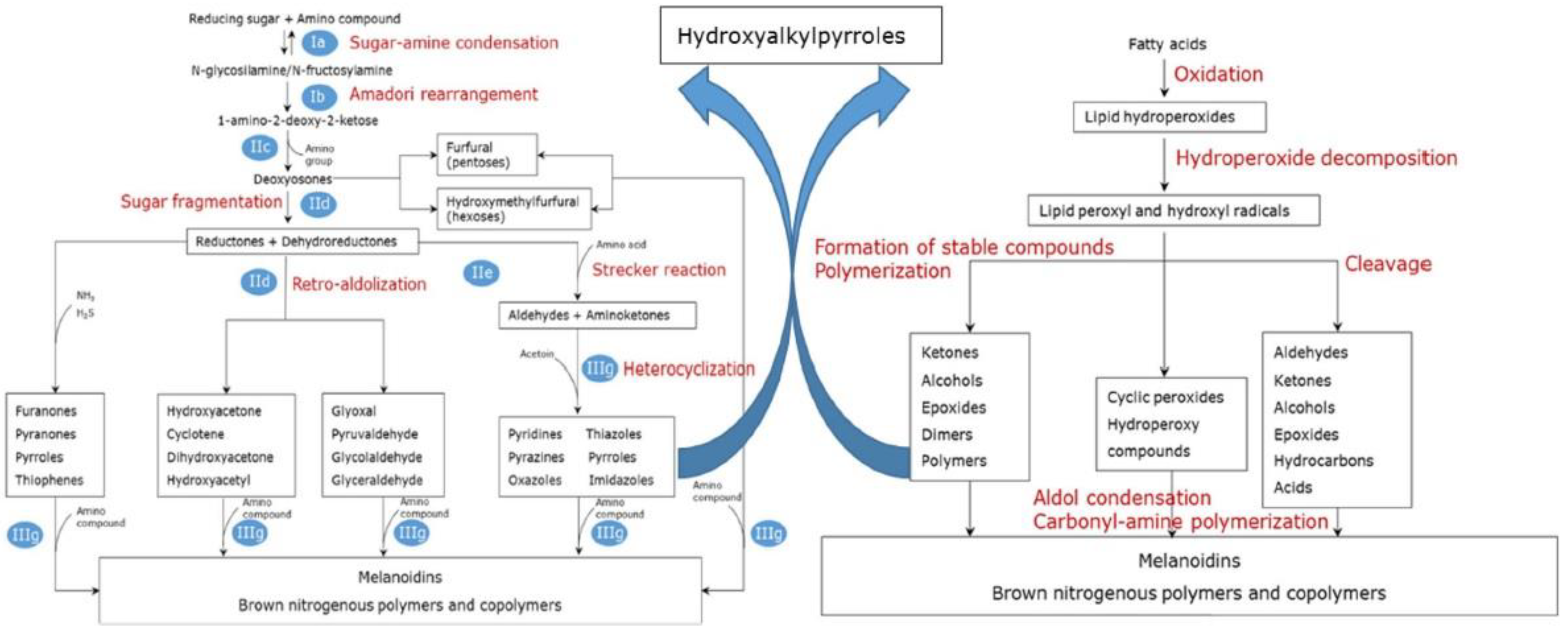

| Classification | Volatile Compound | Relative Content (µg/g) | Odor Descriptors | |
|---|---|---|---|---|
| Beef | Aldehydes | Hexadecanal | 81.41 | Cardboard [82] |
| [82,83] | Nonanal | 5.39 | Fat, citrus [82,83] | |
| Hexanal | 2.08 | Grass, fat [82,83] | ||
| Benzaldehyde | 0.12 | Almond, burnt sugar [82] | ||
| Alcohols | Z-9-octadecen-1-ol | 0.34 | Fatty, animal 1 | |
| 1-octen-3-ol | 0.16 | Mushroom [82,83] | ||
| Ketones | 3-Hydroxy-2-butanone | 0.70 | Buttery, creamy, fatty, sweet [84] | |
| 2-Octadecanone | 0.55 | Green 1 | ||
| Carboxylic acids | Hexanoic acid | 0.89 | Sweat [82] | |
| 2,4-Hexadienoic acid | 0.21 | Acrid [85] | ||
| Nonanoic acid | 0.03 | Fatty, cheese [86] | ||
| Esters | Ethyl acetate | 50.58 | Pineapple [82] | |
| Ethyl 9-hexadecenoate | 0.18 | Fruity [87] | ||
| Furans | 5-Methyl-2-acetylfuran | 0.71 | Nutty [88] | |
| Tetrahydrofuran | 0.66 | Butter, caramel [89] | ||
| Heterocyclic | 3,5-Diethyl-1,2,4-trithiocyclopentane | 2.85 | Beef aroma [90] | |
| Pork [91,92] | Aldehydes | Nonanal | 2.86 | Fatty, floral, wax [93] |
| Benzaldehyde | 2.53 | Bitter almond [93] | ||
| Octanal | 1.97 | Fatty, pungent [93] | ||
| Trans-2-nonenal | 1.47 | Cucumber, farinaceous, greasy, grassy [94,95] | ||
| Heptanal | 1.25 | Fatty, putty [93] | ||
| Hexanal | 0.95 | Green, grass [93] | ||
| Alcohols | 3-Methyl-1-butanol | 3.10 | Pungent [96] | |
| Hexanol | 1.11 | Woody, cut grass, chemical-winey, fatty, fruity, weak metallic [54] | ||
| 1-Octen-3-ol | 0.83 | Mushroom [93] | ||
| 3-Methyl-3-buten-1-ol | 0.34 | Sweet fruity 1 | ||
| Ketones | 2-Butanone | 0.83 | Chemical, burnt, gas, chocolate [97] | |
| 2-Heptanone | 0.80 | Citrus, grapefruit, floral, fruity, spicy, cinnamon [54,98] | ||
| Esters | γ-Butyrolactone | 0.96 | Creamy, pleasant, sweet [84] | |
| Ethyl 2-methylbutanoate | 0.35 | Fruity, strawberry-like [99] | ||
| Carboxylic acids | Hexanoic acid | 0.81 | Goaty [11] | |
| Nonanoic acid | 0.25 | Fatty, cheese [86] | ||
| Sulfur compounds | Methional | 1.74 | Cooked potato, roasted [100] | |
| Dimethyl disulfide | 1.24 | Moldy, pungent, rubbery, onion-like [101] | ||
| Pyrazines | 2,5-Dimethyl pyrazine | 0.24 | Nutty, musty, earthy, roasted, cocoa powder [102] | |
| Furans | 2-Pentylfuran | 1.29 | Green bean, butter [54] | |
| Chicken | Aldehydes | P-methoxybenzaldehyde | 20.90 | Anisic 1, hawthorn-like [103] |
| [104,105,106] | Benzaldehyde | 9.88 | Almond, bitter almond, burnt sugar [82,93] | |
| Nonanal | 0.73 | Fatty, citrus, floral, wax [82,83,93] | ||
| Alcohols | 1-Octen-3-ol | 0.06 | Shiitake mushroom [106] | |
| Ketones | P-methoxypropiophenone | 0.39 | Musty, anisic 1 | |
| Esters | Trans vinyl cinnamate | 0.92 | NR 2 | |
| Furans | 2-Pentylfuran | 0.81 | Green bean, butter [54] | |
| 2-Acetylfuran | 0.21 | Butter, meaty [103] | ||
| Lamb | Aldehydes | Hexanal | 109.23 | Apple, leaf, delicate [107] |
| [107,108] | Heptanal | 31.32 | Nutty, fruity green [107] | |
| (E)-2-nonenal | 30.09 | Fatty, paper [103] | ||
| Nonanal | 18.25 | Fatty, rancid [107] | ||
| Benzaldehyde | 13.09 | Almond, bitter almond, burnt sugar [82,93] | ||
| Alcohols | Hexanol | 12.42 | Woody, cut grass, chemical-winey, fatty, fruity, weak metallic [54] | |
| Carboxylic acids | 4-Methylnonanoic acid | 316.73 | Sweet muttony or goaty [109] | |
| 4-Ethyloctanoic acid | 186.22 | Sweet muttony or goaty [109] | ||
| Acetic acid | 5.09 | Pungent, acidic, cheesy, vinegar [84] | ||
| Esters | Ethyl dodecanoate | 6.18 | Fatty [110] | |
| Furans | 2-Methyl-5-(methylthio)furan | 36.09 | Meat, onion [111] | |
| 2-Pentylfuran | 24.21 | Green bean, butter [54] | ||
| Pyrazines | 2,3,5,6-Tetramethylpyrazine | 15.52 | Chocolate-like [112] | |
| Sulfur compounds | Benzyl methyl sulfide | 4.88 | Roasted, muttony, burning [113] |
| Reference | Type of Meat Sample | Sample Preparation | Weight [g] | Vial | Temperature During Exposure [°C] | Duration of Sample Equilibration [min] | Duration of Fiber Exposure [min] | Compounds Identified (In Total/Odor Active) 1 |
|---|---|---|---|---|---|---|---|---|
| [101] | Beef | Powdered | 1 | 40 mL vial | 60 | 10 | 30, 45, 60 | 96 |
| [119] | Beef | Diced | 10 | 20 mL vial | 4 | 0 | 20 | 35 |
| [120] | Beef | Grounded | 2 | 10 mL vial | 40 | 10 | 10 | 2 (targets) |
| [121] | Beef extract powder | Irradiated | 5 | 20 mL vial | 40 | 0 | 40 | 61 |
| [122] | Pork | Trimmed and cut | 30 | 100 mL reagent bottle | 60 | 5 | 30 | 96 |
| [123] | Pork | Minced | 2 | 20 mL vial | 40 | 15 | 30 | 41 |
| [124] | Pork | Not specified | 2 | 20 mL vial | 65 | 0 | 60 | 30 |
| [125] | Pork | Not specified | 5 | 40 mL vial | 60 | 20 | 40 | 139/29 |
| [126] | Pork | Not specified | 5 | 40 mL vial | 60 | 20 | 40 | 60/26 |
| [127] | Dry-cured pork ham | Homogenized | 10 | 40 mL vial | 50 | 30 | 60 | >40/12 |
| Species | Aim | References |
|---|---|---|
| Pork | Flavor profile, quality | [153] |
| Lipid oxidation | [165] | |
| Boar taint | [168] | |
| Feed composition and ripening time | [169] | |
| Flavor profile | [171] | |
| Adulteration | [173] | |
| Oxidation | [175] | |
| Beef | Spoilage | [163] |
| Lipid- and protein oxidation, flavor profile | [167] | |
| Effect of processing parameter on odor profile | [176] | |
| Flavor profile | [171] | |
| Adulteration | [173] | |
| Freshness evaluation | [177] | |
| Pathogen detection (reviewed) | [162] | |
| Poultry | Lipid oxidation | [165] |
| Freshness evaluation | [177] | |
| Cooking state | [178] | |
| Flavor profile | [179] | |
| Freshness evaluation | [180] | |
| Biogenic amine index | [181] | |
| Other | Flavor profile (donkey) | [171] |
| Flavor profile (sheep) | [171] | |
| Flavor profile (llama) | [172] | |
| Volatile composition (goat) | [170] | |
| Bacterial contamination (goat) | [182] |
Publisher’s Note: MDPI stays neutral with regard to jurisdictional claims in published maps and institutional affiliations. |
© 2022 by the authors. Licensee MDPI, Basel, Switzerland. This article is an open access article distributed under the terms and conditions of the Creative Commons Attribution (CC BY) license (https://creativecommons.org/licenses/by/4.0/).
Share and Cite
Bleicher, J.; Ebner, E.E.; Bak, K.H. Formation and Analysis of Volatile and Odor Compounds in Meat—A Review. Molecules 2022, 27, 6703. https://doi.org/10.3390/molecules27196703
Bleicher J, Ebner EE, Bak KH. Formation and Analysis of Volatile and Odor Compounds in Meat—A Review. Molecules. 2022; 27(19):6703. https://doi.org/10.3390/molecules27196703
Chicago/Turabian StyleBleicher, Julian, Elmar E. Ebner, and Kathrine H. Bak. 2022. "Formation and Analysis of Volatile and Odor Compounds in Meat—A Review" Molecules 27, no. 19: 6703. https://doi.org/10.3390/molecules27196703
APA StyleBleicher, J., Ebner, E. E., & Bak, K. H. (2022). Formation and Analysis of Volatile and Odor Compounds in Meat—A Review. Molecules, 27(19), 6703. https://doi.org/10.3390/molecules27196703





